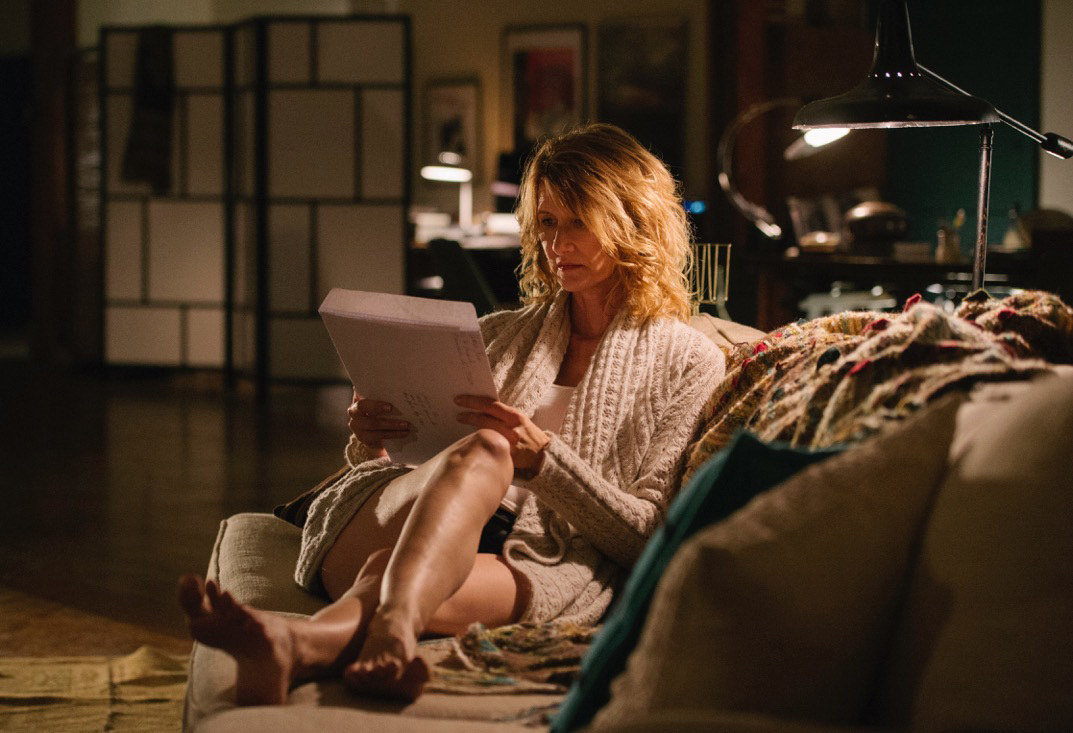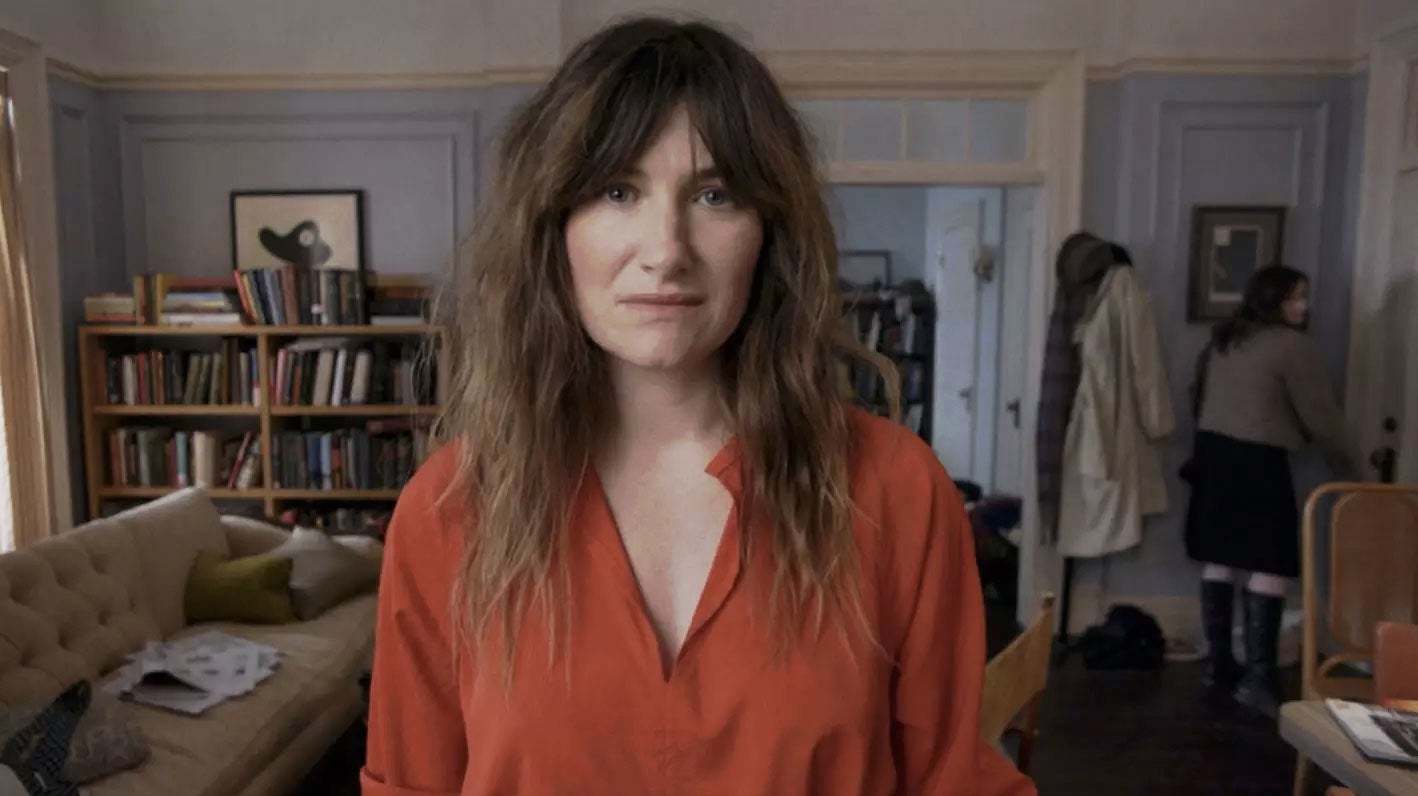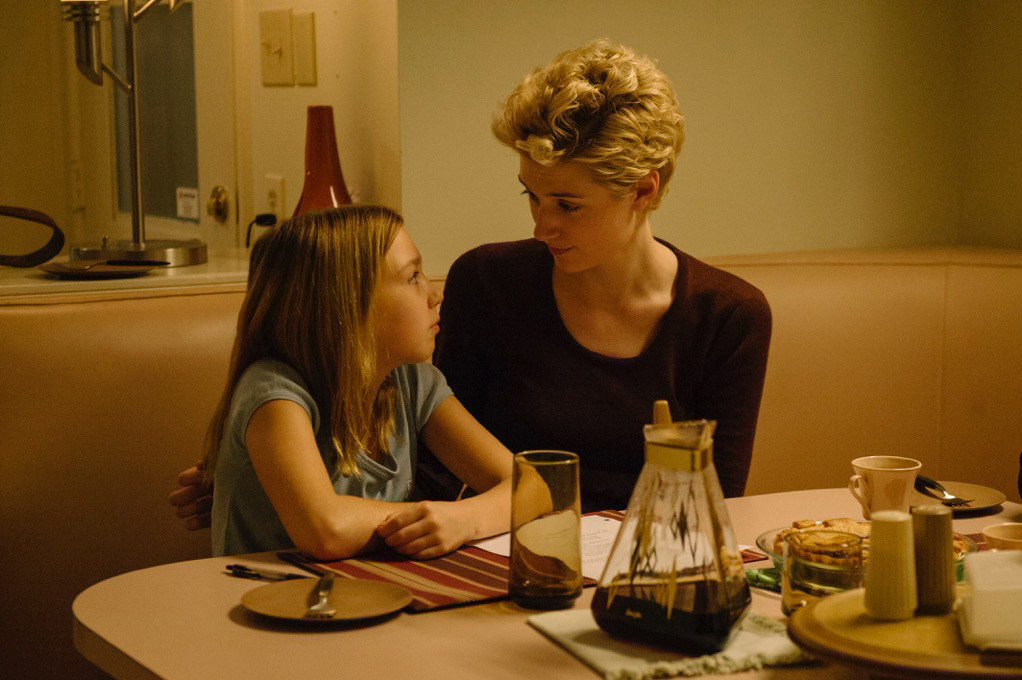
The Tale is a movie about a woman coming to terms with the fact that she was sexually abused when she was a child. It's not her recollection of the sequence of events themselves, unfolding and escalating over the course of several months when she was 13, that changes, but the context in which she understands those memories — the story that she's been telling to herself about what happened. It’s a movie about denial as self-protection. Forty-eight-year-old Jennifer (Laura Dern), the onscreen stand-in for writer-director Jennifer Fox, keeps using words like "relationship" and "lovers" to describe what occurred between her and her then–40-year-old running coach Bill (Jason Ritter). It's a narrative she's insisted on to the point where it has become, in some ways, key to her sense of self — that she was precocious and daring, not being taken advantage of by an adult; that she was the heartbreaker, not the victim.
Then memories, triggered by a few dug-up artifacts from that time — a starry-eyed confessional essay she passed off as fiction to a teacher, some photos that show clearly just how young she actually was — come rushing in, and she's compelled to reexamine her past through grown-up eyes. And so are we, all the way back to the excruciating evenings during which Bill strategically flattered young Jennifer (played by then–11-year-old Isabelle Nélisse), groomed her, and pressured her into sexual contact. The movie makes little effort to disguise the fact that an adult body double subs in for Nélisse in any scenes involving the latter, which doesn't soften the terrible impact of what those scenes depict — the way Bill tells Jenny she should be grateful that he's stretching her before he eventually penetrates her ("No young boy would ever do this for you"), or how present-day Jennifer spits that he couldn't have gotten her pregnant, because she hadn't gotten her period yet. The Tale, which debuted on HBO on Saturday and is now available on demand, is autobiographical, and holy hell, do you feel it in the brutal frankness of those details.
The Tale doesn't allow the sexual violence it depicts to exist in a vacuum.
When The Tale premiered at the Sundance Film Festival in January, it was those sequences, which run down its center like a wound, that I would hear people talking about afterward in the hushed tones of attendees at a funeral. They were scenes intended to shock, to remove any room for rationalization or euphemism. And, although Fox had been working on the film for years, the timing meant it was inevitable — and important — that the movie would be seen through the lens of #MeToo. “I absolutely feel if we had been at Sundance a year ago, I don't think people would have had the stomach for it,” Fox told BuzzFeed News. The Tale resonates with other #MeToo testimonials in so many ways — in the abuse of power it depicts, in the way it shows how other women can be complicit in enabling or excusing abuse, and in its exploration of why someone might not speak up for years, or decades, about a past assault.
If it's a #MeToo movie, though, it's also one that insists on the direction the conversation can and should take, as the movement appears to be slowing or preparing to take a turn toward whatever's next. The Tale serves as an emphatic, self-contained argument that, rather than debating when various exiled men will be allowed to return to the spotlight they retreated from, we should shift our attention to the people those men targeted, looking not just at the experiences they've shared but at how those experiences exist within their lives.
The Tale doesn't allow the sexual violence it depicts to exist in a vacuum. Instead, Fox folds the pivotal events of her story into a larger examination of the subjectivity and slipperiness of memory and how we can't choose which aspects of the past inform the people we become. It's #MeToo as an act of autobiography, and it serves as a potent reminder of how much of this moment has still been centered on the behavior, the statements, and the psyches of the men accused, rather than how their actions ripple through the lives of the people who have taken the risk of speaking up against them.

One of the paradoxes of the #MeToo movement (and of cases like those of Woody Allen, Bill Cosby, and Roman Polanski, that preceded but have since become a part of it) is that the movement has been facilitated and amplified by the prominence of its accused men — the same prominence that shielded them for so many years before this dam broke. It's a movement that has emphasized how widespread sexual harassment and assault are — me too — by documenting patterns of abuse, using accounts from multiple accusers to establish credibility and underscore the habitual nature of many violations. This collected testimony builds a fuller portrait of the alleged perpetrators, which is why these stories have felt so unignorable, but it has also meant that the conversation has remained largely focused on these men: They stand at the center of each story, while their accusers blur around them into a mournful chorus.
This was most vividly realized in New York magazine's July 2015 Cosby cover, on which 35 of the women who've spoken out about being assaulted by the recently convicted comedian were posed along with an empty chair symbolizing those who've yet to come forward. It was an immensely powerful piece of work, all those faces and all those statements, but it was ultimately — of course! — a story about Cosby, that got its heft from the terrible weight of those combined accounts, the women pixels in a pointillist portrait of a predator hiding in plain sight. The same became true with Harvey Weinstein when accusations piled up so quickly that writers compiled lists to help people keep track of how many there were.
These men stand at the center of each story, while their accusers blur around them into a mournful chorus.
There's been an inadvertent effect of reducing people who've spoken up to some of their worst experiences, casting them as passing victims in someone else's narrative. In February, the Hollywood Reporter even ran what was effectively a Weinstein origin story, speculating about whether he owed his temper to his mother, offering evidence of his class-climbing aspirations, and delving into his early awkwardness with women, poring over those formative years like an endlessly fascinating psychological bounty. He, not the dozens of women who made allegations of abuse against him, remained the protagonist. Weinstein’s arrest on rape charges in New York City last week was a vindication for his alleged victims, but their voices were effectively, inevitably, a soundtrack to the central spectacle of his perp walk.
In March, This American Life ran its own #MeToo story in an episode titled "Five Women," which was inspired by "A Short History of Weird Girls," a stand-alone and standout episode of Jill Soloway's Amazon series I Love Dick. “Five Women” took as its starting point a story, first reported by BuzzFeed News, about how sexual harassment claims from five journalists employed by the progressive outlet AlterNet led to the resignation of its executive editor, Don Hazen. "Five Women" couldn't have existed without that work, and without the larger conversation that had preceded it, but reporter and producer Chana Joffe-Walt used all of that as groundwork for an installment that made the women, not Hazen, its focus. It didn't just include their individual accounts of harassment; it delved into their respective backgrounds, into the behavior they'd learned to expect from men, how they'd come to think women should behave around men (and, sometimes, judge them for it), and how, in turn, those things affected the way they reacted to Hazen's actions.

There is nothing uniform about their stories, aside from a tendency to cite things that happened to them when they were 13, the same age Jennifer Fox was in the flashbacks in The Tale. It’s an age when a lot of young women first notice they're being regarded in a sexual context, whether they've ever thought of themselves in that way or not. Onnesha Roychoudhuri describes how, at that age, she came to feel that sexual attractiveness was a "false power," and how it later led her to turn down a raise from Hazen when he presented it as a benefactor helping a girl pay rent, rather than rightful compensation for an employee’s work. Kristen Gwynne talks about how she was raped at a party as a teenager, why it took her so long to use that word for what happened to her, and why that meant she had no hesitation when it came to calling Hazen's behavior inappropriate. Tana Ganeva says that she thought of her ability to tolerate bullying and harassment as a sign of her own toughness, to the point where she mentions feeling it was her responsibility to set clear enough boundaries.
These stories were messy, they were complicated, and they were incredibly compelling, filled with questions as well as with anger. The episode ends with an exquisitely challenging interview with Hazen's partner, Vivian Dent, who isn't surprised by or seemingly all that interested in the harassment claims, but who expressed an enormous sense of betrayal over Hazen's infidelity. “Five Women” reflects a conversation that, despite what backlashers have tried to claim, has never seemed monolithic to me, or intent on painting all of the accused with the same brush. More than that, it felt like it was filling in part of the neglected other side to these accounts of misconduct, addressing something I hadn't realized I'd been missing and yearning for more of.
"There is no #MeToo moment that is actually separate from the rest of our lives," Joffe-Walt says in the episode, a point that should be obvious, but that is also quietly revelatory. There's no contending with sexual harassment and assault as systemic if narratives just end with the accused retreating from view, the bad man banished and off to a happily ever after. There is so much more to the story than that.

Watching The Tale a second time, the scene that stuck in my head wasn't one from the horror show that is Bill's skillful seduction of a lonely, vulnerable adolescent. It's instead the moment in which grown Jennifer realizes the extent to which Bill shaped her expectations about sex, and her ideas about relationships and children, long after she excised him from her life. Jennifer Fox, like the character standing in for her onscreen, was a documentarian before making The Tale, her first scripted film, and the kind of documentarian who makes a six-hour movie mapping her personal crises against the experiences of women around the world.
Having such certainty in the boundless fascination of your own inner depths is a quality that can lead to navel-gazing or self-indulgence, but that's not at all the case in The Tale, where Jennifer's insistence on self-exploration and on her place at the heart of the film is essential. We watch her watching footage of interviews in which she talks with a few different women about sex. She listens to herself say, "I wasn't abused, but for me, it took me years to get comfortable to have an orgasm with a man," and she shatters, understanding that Bill left marks on her she never noticed because they were hidden away in her assumptions about what was normal.
The Tale takes the form of a mystery in which the basic events are known, and it's the motivations that needed to be sussed out: what people were thinking and feeling, how much they knew, why they (and she) did what they (and she) did. Jennifer tracks down figures from her past, and is questioned in turn — "I just don't understand, why did you keep going back?" her mother (Ellen Burstyn) asks, not grasping the validation her daughter got from the rapt attention of an adult she admired. But the movie's striking central device is the way it allows her to conduct impossible interrogations of the characters’ younger selves, who speak to the camera, answering her questions and challenging her about what she'd thought was true. It’s an incendiary fantasy about cinematically enabled closure.
Mrs. G, the riding instructor Jenny idolized, who introduced her to Bill, is far from forthcoming when played by Frances Conroy in the present day. But in this imagined space, Jennifer tells Mrs. G's past incarnation (Elizabeth Debicki), "I was waiting for you to save me," and she responds darkly, "No one saved me." Toward the climax of the film, Jennifer confronts her 13-year-old self about things she can't change and can't really comprehend changing. How do you conceive of an alternate you? "You want me to be some pathetic victim. Well, you know what? I'm not," her teen self snaps, drawing herself up tall and insisting on her place at the center of the narrative. "I'm not the victim of this story, I'm the hero. He fell apart, not me."
Why would anyone choose to be the victim rather than the hero?
And why would anyone choose to be the victim rather than the hero, presuming those labels are mutually exclusive, the only ones available, and you must pick one of the two? Who wouldn't opt to be the hero, even if it also means opting for silence? In young Jennifer's view, victims are the people things happen to, whereas heroes are the people who make things happen. They have agency and choice. They tell the stories, rather than turning up as part of the collection of names in someone else's apology. It's a false dichotomy, and a monstrous one, but you can see how it's a faulty conclusion someone could still draw from a lot of #MeToo reporting today.
"It was never on my vision board to be a Time magazine 'silence breaker' or a lifelong goal to be pictured in People magazine, labeled as a 'victim,'" the actor, comedian, and writer Rebecca Corry wrote in Vulture on Thursday about her difficult decision to come forward about being harassed by Louis C.K. She revealed that she's been attacked for speaking up and berated for not speaking up soon enough, that she's lost friends and gained support. She also mentioned that, incredibly if not surprisingly, she's been asked about the viability of C.K. making a comeback — pushed again into the role of a supporting character commenting on the life of the leading man.
We're far from done with #MeToo. But watching The Tale, listening to "Five Women," and reading pieces like Corry's, what's underscored is how much more of a conversation there is to be had, and how deeply ingrained the impulse is to keep putting those powerful men back at the center of it, to make the story into one about their rehabilitation, what they've lost, and what they've learned. That's a narrative, sure, but it's hardly the only one, and there are so many more out there that aren't being told, that move beyond the moment someone's life intersected with that of their abuser. Alongside the ongoing battles against inequality in the workplace that #MeToo has given extra momentum to — ones that could change who gets to tell stories in the first place — there are also battles to be fought about how these stories are framed.
In the last scene of The Tale, Jennifer finally tracks down Bill, who she's been searching for and trying to get in touch with throughout the movie. She travels to an event being held in his honor, and finds herself face to face with him for the first time in years, this man who hurt her and, it's suggested, many others after her, and who's faced no consequences for it. Most of the scenes in the movie have a basis in fact, but that one does not. "I never confronted him like that because, frankly, my goal was more to understand him, and to keep the dialogue open," Fox said in a recent interview. It is, instead, a startlingly effective act of fiction, in which Fox turns her abuser into an accessory in her own narrative, a means to an ending. This is a story about her, and it affirms that there are ways to speak openly about the wrongs done to you and still be the hero of the tale. ●
More on The Tale:
